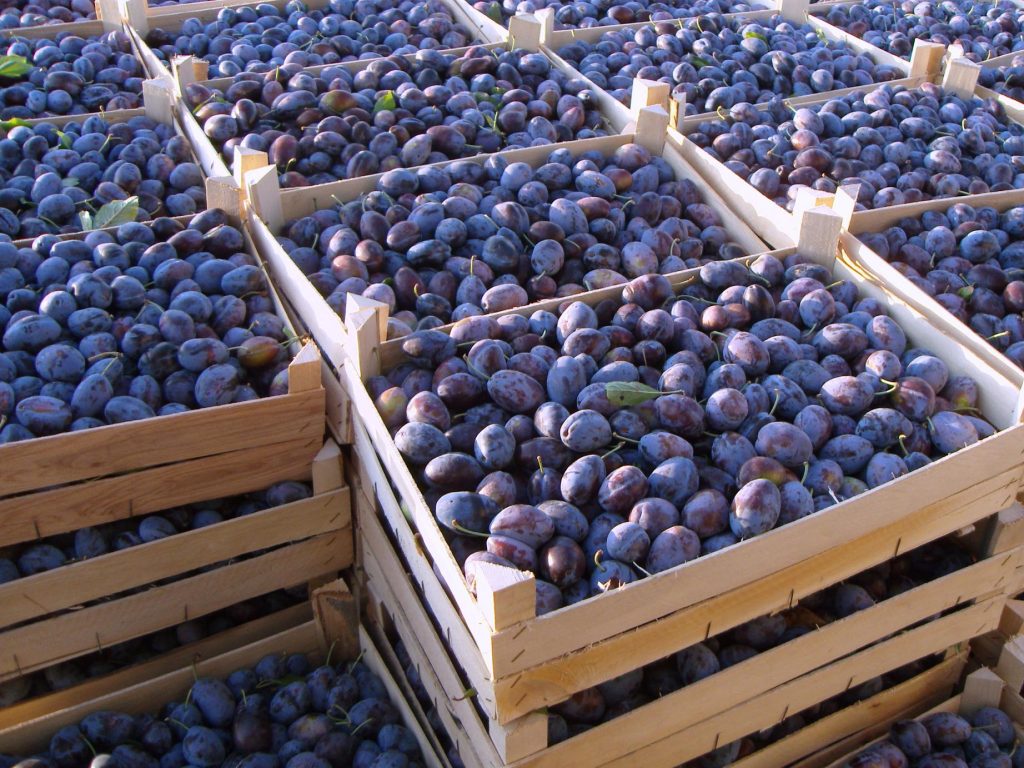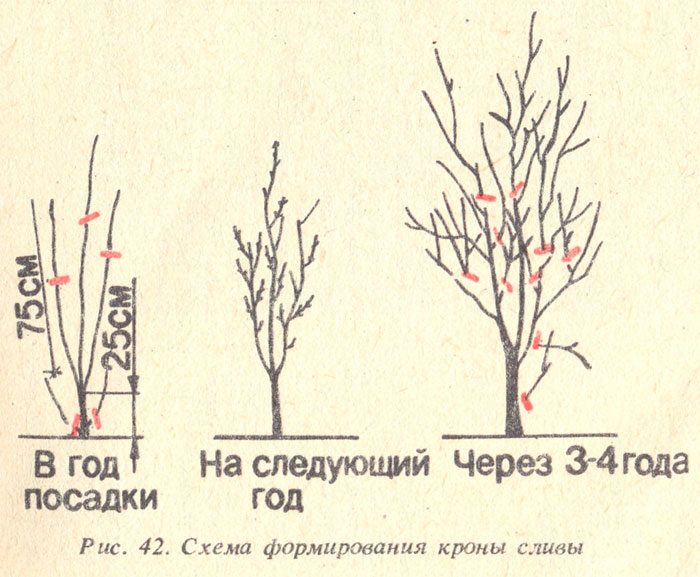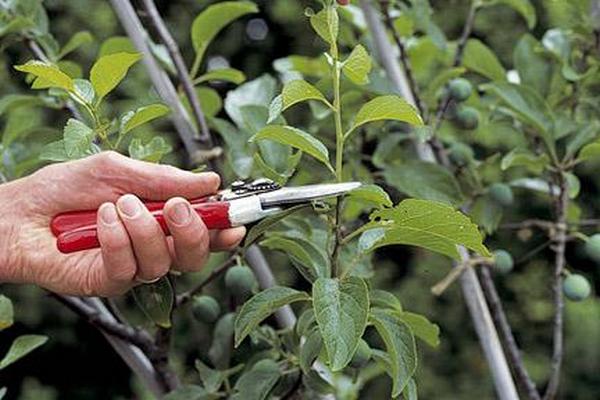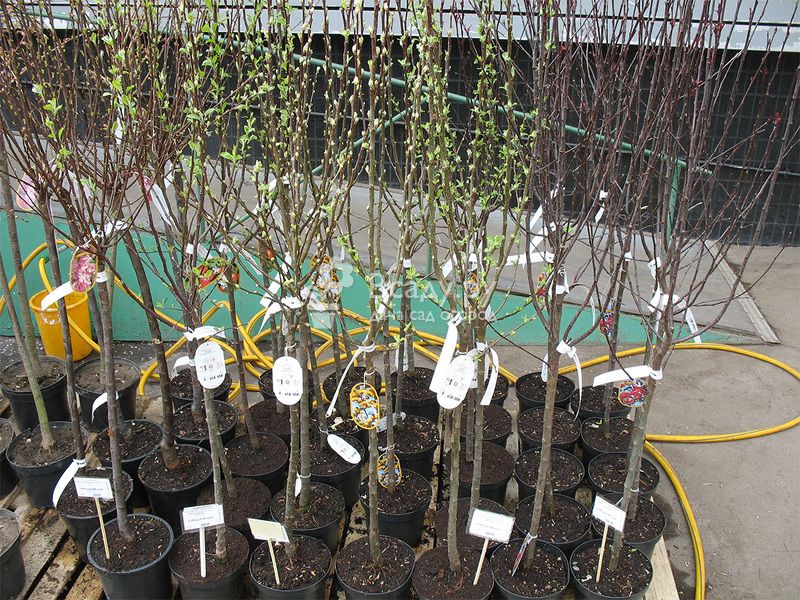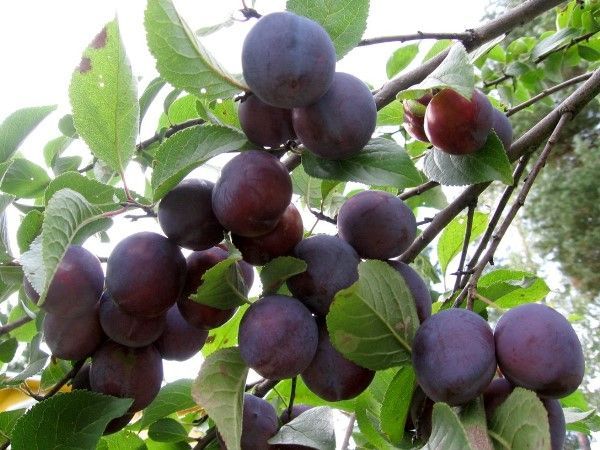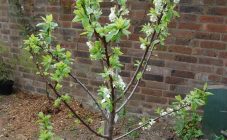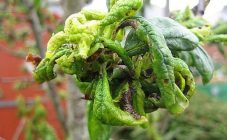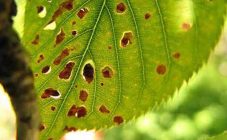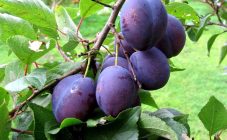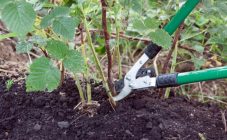Content:
The plum tree belongs to the Rosaceae family, growing in length from 3 to 10 m. Fruits, depending on the variety, ripen from July to October. Plums weight from 6 to 100 grams, color can be yellow, green, pink, blue. The fruits are sweet, with a slight sourness, tasty and healthy for the gastrointestinal tract. Knowing how to plant a plum and grow a healthy tree, you can get good yields every year.
About culture
When and how the garden plum appeared is unknown, but there is a version that this fruit crop was the result of crossing blackthorn and cherry plum. Today, more than 1000 varieties of plums have been created, of which 20-30 varieties are especially popular with gardeners. The life span of a plum tree is about 25 years. Early varieties begin to give a good harvest at the age of 2-3 years, mid-ripening - by 4 years, late-ripening - by 5-6 years. The root system of the plum is pivotal, it goes 20-40 cm deep into the soil. 1-3 flowers of a white or cream shade appear from the flower buds.
The fruits are used fresh, for making jam, compote, liqueur, wine, sauces, marmalade.
How to distinguish plum from cherry plum
Not all gardeners can distinguish plum from cherry plum, because these crops have many similar characteristics. Common cherry plum is a type of plum.
External signs
The common plum grows in a tree that is over 6 meters high. Cherry plum looks like a tall shrub with a spreading crown, sometimes its height is up to 12 meters.
The leaves of the plum tree are larger than those of the cherry plum, with a bit of fluff on the underside. Cherry plum has smooth, shiny leaf plates up to 4 cm in length.
Fruit
Both crops, depending on the variety, have fruits of different weight. But often plums are larger than cherry plums. Yellow and reddish color of the fruit is inherent in both crops, but shades of blue with a characteristic matte bloom are found only in plums. Most often cherry plum has a yellow-green or reddish color.
The taste of plum is sweeter, juicy, with a dense pulp, and cherry plum has a sour taste with a watery structure.
Fruit ripening
Cherry plum begins to produce crops in the second year after planting, while the fruits ripen not earlier than the end of August. Plum begins to bear fruit in 3-4 years, and the ripening of the crop in some varieties occurs at the end of June.
Selection of seedlings
When choosing seedlings, pay attention to the stem; for cherries, apricots and plums, the thickness of the trunk should be at least 15 mm.
- annual plum saplings can be without branching;
- two-year-old trees have three lateral branches, 30 to 40 cm long;
- bark without damage.
When choosing young plums, the appearance of the root system is of great importance. Healthy seedlings have the following indicators:
- developed fibrous roots;
- length 25-30 cm;
- without damage;
- dry condition.
There are seedlings on sale that are four or five years old; it is highly undesirable to acquire such large trees. Many gardeners believe that the older the seedling, the faster it will grow and begin to bear fruit. But this opinion is erroneous, when digging, the roots are damaged, the trees get sick and lag behind for a long time.
How to plant plums
Plum planting is possible both in spring and autumn, while it is important to remember that this culture does not take root well during the heat. In the autumn, planting must be completed by October 15th. So the seedling will have time to take root before severe frosts. In the spring, the plum must be planted before budding, in the middle lane and the Moscow region the best time is the end of April or the beginning of May.
When choosing a site for planting plums, it is necessary to take into account the height and strength of the future tree, shrubs and other plantings should not block the sun and hinder development. Since this crop blooms earlier than others, low-lying areas that are subject to frost should be avoided. It is good to plant these fruit trees along fences, on a sunny side, protected from the wind.
Plums thrive in open, sunny places, like moist soil, but cannot grow in flooded areas.
Sandy loam and loam are more suitable for draining; groundwater should lie at a depth of 1.5-2 meters.
Plum trees should not be planted in peat bogs. On the site of the former plum garden, seedlings of a similar culture are planted only after five years. This is the amount of time needed to restore soil fertility.
How to plant a plum correctly
About two weeks before planting the seedling, pits are prepared. Their depth is 60 cm, and their width is 70 cm.The soil from the pit is mixed with humus in a 2: 1 ratio. The hole is filled with the resulting mixture and a seedling is placed in the center so that the root collar protrudes 5-7 cm above the ground. The soil is tamped with hands so that no voids remain, a peg is placed next to the drain and the tree is fixed. The distance between the trunk and the support should be at least 15 cm. If the peg is too close, the delicate bark can be injured. The tree is watered abundantly and the trunk circle is mulched. This technique will help keep moisture longer.
In the Urals, plum saplings are planted in the spring as soon as the snow melts and the temperature is above zero.
How to care for a plum
Plum care should be comprehensive.
Moisturizing
The first watering is carried out 1.5-2 weeks before the buds appear. If the summer is dry, abundant watering is necessary every month. In August and September, with insufficient precipitation, plums are also watered. However, over-irrigation can lead to cracking of the fruit and yellowing of the leaves.
Pruning
In the first year after planting, all weak shoots are cut off, leaving only strong, even branches. Ideally, after pruning, the shoots form several tiers, while the upper branches should be shorter than the lower ones. The shoots remaining after pruning form an angle of 40 ° or slightly more with respect to the trunk.
After the formation of the crown, sanitary pruning is carried out and branches that grow inward are removed, interfering with the main shoots.
Pruning of columnar drains is carried out as needed, in this case dry or damaged branches are cut.
In Siberia, the plum grows as a bush, therefore, when pruning, they maintain this shape so that the plant can withstand severe winters as successfully as possible.
Additional food
In the second year after planting in early spring, the plum needs care. For this, the tree is fed with urea, approximate dosage: 20 grams per 1 sq. M.When the seedling reaches the age of three, fertilizers are applied three times per season. After the introduction of urea in early spring, nitrophoska is used for the second feeding in early June. Three tablespoons of the substance are stirred in a large bucket of water.
Superphosphate and potassium sulfate are used in the second half of August, two tablespoons of each fertilizer are taken in a bucket of water. According to the instructions, two buckets of nutrient solution are poured under each tree.
When the plum begins to yield a crop, a solution of urea and potassium sulfate is added before flowering (2 tbsp. L per bucket of water). You can also use the following formulations:
- Novofert;
- Turbo health;
- ROYAL MIX;
- Fertile;
- Berry.
The third complex feeding is needed after flowering, in addition to complex fertilizers, a solution of bird droppings or mullein is suitable. For one part of the fermented bio-fertilizer, take 20 parts of water.
Preparing young seedlings for winter
The young tree must be protected from frost and rodents. To do this, the trunk circle is insulated with straw or sawdust, then pine or Christmas tree branches are laid. If in the area where the plum grows, there are very often snowy winters, a piece of old slate or other shelter is installed next to the seedling. In addition to spruce branches, peppermint sprigs protect against rodents. With the onset of spring, all shelters are removed.
Harvesting
The ripeness of plum fruits is determined by the correspondence of color, size to the variety. For plum harvests, the fruits are harvested a few days before full ripeness. In the preparation of jam, only well-ripened plums are used. In this case, you do not need to tear each plum separately, but simply shake the tree. If the fruits are planned to be transported over long distances, the plums are removed from the stalk.
Regionalized varieties
Moscow region and middle lane:
- Hungarian Moscow- sweet fleshy flesh with dark skin;
- Yellow honey - sweet pulp with honey flavor, yellow skin on fruits;
- Souvenir of the east - high-yielding variety, medium-sized fruits, orange or reddish hue.
North-West, Leningrad region:
- Alyonushka - fruits are large, round, fruit color is pink-red, juicy pulp, orange hue, dessert taste;
- Mara - fruits of medium size, golden yellow in color, small stone fused with pulp;
- Etude - fruits ripen in summer, plums are of medium size, egg-shaped, sweet and sour taste. Tree with an open crown, resistant to pests and diseases.
Ural and Siberia:
- Pearl of the Urals - sprawling tree, round-shaped plums, green-red in color, sweet and sour taste;
- Chebarkulskaya- a medium-yielding variety, from one tree you can collect up to 15 kg of dark blue plums, sweet-sour taste;
- Snow White- the variety tolerates frost well over −40 degrees, the fruits are globular, bright yellow in color, with a white waxy bloom;
- Peresvet- a variety of early ripening, the first plums can be harvested in mid-August. Plums are orange in color with a small red spot, sweet taste.
- Altai anniversary- grows well both in Transbaikalia and in the Urals. The fruits are bright orange in color with a scarlet spot. The pulp is juicy, aromatic sweet.
Typical diseases
- Dog burn. This disease affects plum leaves. The fallen leaves are burned, the tree is sprayed with 1% Bordeaux liquid and 0.25% perocin 75 B.
- Rust. The disease is provoked by a fungus, white spots appear on the foliage, then dark spores. The tree is sprayed twice (repeat after 14 days) with 1% Bordeaux mixture.
- Gum therapy. Wounds form on the trunks and branches, from which gum oozes. The damaged areas are treated with 1% copper sulfate.
- Hole spotting. The fungus begins to develop in warm rainy summers. Spores are carried to the tree by wind or insects.The fight against infection is carried out with the help of Skor or Topaz preparations.
Pests
- Galovi mite. The tree is treated with colloidal sulfur.
- Goldtail. Apply karbofos solution.
- Plum sawfly. One of the following drugs is used: phosphamide, dursban, metaphos.
For preventive purposes, fallen leaves are burned in the fall. In this way, many pests that hibernate in plant debris are destroyed. Spring processing can be started as soon as the positive temperature is established. Bordeaux liquid is most often used against diseases, and in the fight against moths, sawflies, leaf rollers, aphids, such drugs as fitoverm, fufanon, karbofos are effective.
Useful Tips
- Low-winter varieties should be grafted only on undersized trunks.
- For a good growth every year, you need to thin out the crown.
- For a high yield, 2-3 varieties are planted in an open area.
- Plum loves nitrogen fertilizers, this condition is important to consider when organizing feeding.
- Plum is easier to care for if it is grown in a fan-shaped manner.
Care and cultivation of plums is a feasible task, since this crop does not require complex care. When choosing a variety, it is worth giving preference to zoned seedlings, since they are already adapted for growth in appropriate weather conditions. Plum saplings, like other crops, must be purchased in specialized nurseries, only in this case there is a guarantee of the conformity of the variety.
